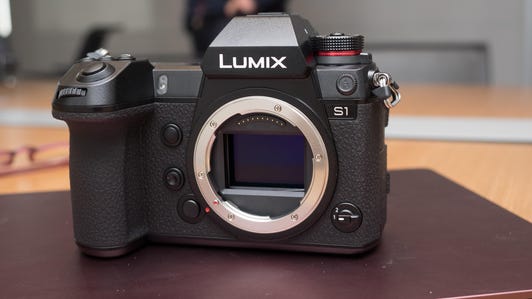Mimicking Sony’s prototypical pro-entry-video full-frame camera strategy, Panasonic’s following up its Lumix S1R (pro) and S1 (entry) with a video-oriented addition to its S1 full-frame mirrorless line, the Lumix S1H, slated to ship sometime between September and November. Panasonic is targeting about $4,000 for the camera (roughly £3,165 and AU$5,760), which it’s showing under glass at Cine Gear Expo.
Even if 6K video isn’t an end in itself — the present is 4K and the future seems to be 8K — shooting 6K video provides some spatial latitude when you’re ultimately going out to 4K. So, for example you can add pans, zooms and similar effects in post without as much degradation in quality as you might otherwise have. The computing power to edit in 6K is also, if not mainstream, at least more widely attainable.
Using the full 35mm-size sensor, the S1H will record 6K/24p video (probably 6,048 x 4,032); cropping to 16:9 aspect it will record 5.9K/30p. It will also support 4:2:2 10-bit DCI and UHD 4K and crop to anamorphic (4:3) and Cinemascope (2.39:1) aspect ratios in 4K. And like the GH5S, it will record for an unlimited time provided it can take the heat and support the V-Log profile for 14-plus stops of dynamic range. With the V-Log profile the intention is to match the look of the company’s high-end VariCam cinema cameras.


Now playing:
Watch this:
Why we need 16 cameras on a smartphone
2:02
Sony’s eagerly awaited A7S III, the replacement for its A7S II full-frame video-focused model, is still in limbo, and the company said as recently as April that there have been some technological obstacles to releasing the camera with the capabilities it wants to, so Panasonic may be taking advantage of the vacuum while it exists.
Since it’s based off the body of the S1 and S1R, it will use the L-mount lenses, which Panasonic says were engineered from the start for video, for example with minimized focus breathing. You’ll be able to use PL-mount cinema lenses with an adapter as well.
Around the time of its official launch we may also see the three core L-mount pro lenses Panasonic’s has on its second-half 2019 road map, the 24-70 f2.8, 70-200 f2.8 and 16-35mm f2.8. The new teleconverters shipping in July, a 1.4x (DMW-STC14) and 2x (DMW-STC20), will work with the forthcoming 70-200mm lens as well as the f4 version currently available.
At the moment, the only camera shooting 6K on a 35mm full-frame-size sensor is the Sony Venice, which starts at about $40,000 and has a traditional pro video camera design (of course, it has a wider dynamic range of 15-plus stops, too). Most use smaller Super 35-size sensors which have different depth-of-field characteristics than full frame, which you may or may not care about. The S1H is bigger than a Micro Four Thirds model like the GH series, but also has a sensor that probably boasts a better tonal range.
Panasonic’s Lumix S1/S1R is a giant among mirrorless cameras






There’s a ton we still don’t know about the camera. Probably the most burning question is whether it will have a sensor with a global shutter, which is one of the most in-demand features for many of these filmmaker-targeted cameras; in contrast to the common rolling-shutter CMOS, global shutter prevents artifacts like the Jell-O effect you see on objects moving horizontally and fast through the frame. We don’t know the sensor resolution for still shooting, either, but it will have to be at least 24MP to accommodate the 6K video.
While the S1H is not an 8K video camera, it could conceivably use a variation of the 8K organic sensor jointly developed by Panasonic and Fujifilm which was announced last February and which is supposed to ship in a commercial design later this year.
Another big question mark: in-body image stabilization. While it’s likely, I’ve learned never to assume that its existence in one model of a line means it will be in them all.
It will probably have the same audio specs as the GH5S as well. In fact, most of the capabilities that can be added to the S1 starting in July via a $200 paid firmware update (DMW-SFU2) will most likely make it into the S1H, too. (Directly converted, approximately £158 and AU$290.) They include internal 4:2:2 10-bit 4K/30p, external 4:2:2 10-bit 4K/60p, V-Log and V-Gamut LUTs, in-camera waveform monitor and support for internal 48-kHz/24-bit or 96-kHz/24-bit sound recording via optional XLR mics.
And lest you fear this is a sign that Panasonic’s letting its Micro Four Thirds cameras languish, the company also announced a fast, weather-resistant zoom for the line: the Leica DG Vario-Summilux 10-25mm f1.7. There’s no pricing or availability for it as yet, though.




